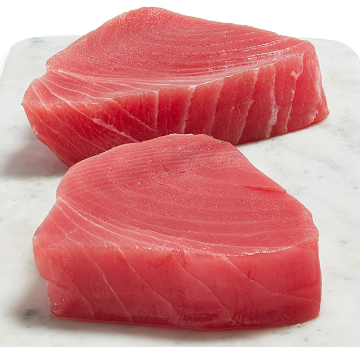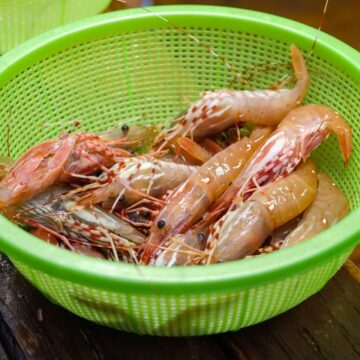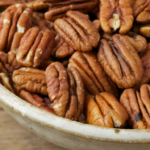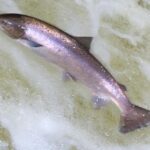As pet owners, we always want to ensure that we are providing our furry friends with the best possible nutrition. While there are countless options for dog food out there, have you ever considered adding salmon to your pup’s diet? This nutritious fish is loaded with omega-3 fatty acids, protein, and essential vitamins and minerals that are beneficial for your dog’s overall health. However, as with any food, there are also potential downsides to consider.
In this article, we’ll see if dogs can eat salmon, including its potential benefits for their skin and coat, potential risks of mercury contamination, and how to properly prepare and serve this fish to your furry friend. So, grab a bowl of water for your pup, and let’s dive into the world of salmon for pups!
The Nutritional Benefits of Salmon for Dogs
Salmon is an excellent source of protein, which is essential for your dog’s overall health. Protein helps to support muscle growth and repair, and it also plays a key role in the development of strong bones and teeth. Additionally, salmon is rich in omega-3 fatty acids, which are important for maintaining healthy skin and a shiny coat. Omega-3s also have anti-inflammatory properties, which can help to reduce joint pain and inflammation in dogs with arthritis or other inflammatory conditions.
In addition to protein and omega-3s, salmon is also a good source of vitamins and minerals. It contains vitamin B12, which helps to support your dog’s nervous system and brain function, as well as vitamin D, which is important for strong bones and teeth. Salmon is also rich in minerals such as selenium and potassium, which are important for maintaining healthy immune function and muscle function, respectively.
Overall, adding salmon to your dog’s diet can be a great way to provide them with a wide range of essential nutrients that are important for their overall health and wellbeing.
Risks of Feeding Salmon to Dogs
While salmon can be a nutritious addition to your dog’s diet, there are also potential risks to consider. One of the main concerns when it comes to feeding salmon to dogs is the risk of mercury contamination. Some types of salmon can contain high levels of mercury, which can be harmful to dogs in large amounts.
Additionally, salmon can also contain parasites such as tapeworms, which can be dangerous for dogs if not properly cooked. These parasites can cause a range of symptoms, including vomiting, diarrhea, and weight loss. To minimize the risk of parasite contamination, it’s important to always cook salmon thoroughly before feeding it to your dog.
Finally, some dogs may be allergic to salmon or other types of fish. Signs of an allergic reaction can include itching, hives, and swelling, and in severe cases, difficulty breathing. If you suspect that your dog may be allergic to salmon, it’s important to speak to your veterinarian before introducing it into their diet.
How to Safely Prepare Salmon for Your Pup
If you’ve decided to add salmon to your dog’s diet, it’s important to know how to properly prepare and serve it to minimize the risk of contamination and ensure that your dog gets the maximum nutritional benefit.
First and foremost, it’s important to always cook salmon thoroughly before feeding it to your dog. This means cooking it until the internal temperature reaches at least 145°F. You can bake, grill, or poach salmon to achieve this temperature.
Additionally, it’s important to avoid seasoning salmon with any spices or herbs that may be harmful to dogs, such as garlic or onion powder. Stick to simple preparations, such as baking or grilling with a little bit of olive oil.
Finally, it’s important to remove any bones from the salmon before feeding it to your dog. Fish bones can be small and sharp, and they can pose a choking hazard or cause damage to your dog’s digestive tract.
How Much Salmon to Feed Your Dog
When it comes to feeding your dog salmon, it’s important to do so in moderation. While salmon is a nutritious food, it should not make up the majority of your dog’s diet.
A good rule of thumb is to feed your dog salmon once or twice a week, and to make sure that it makes up no more than 10% of their overall diet. This will help to ensure that your dog is getting a balanced and varied diet, and that they are not consuming too much mercury or other potential contaminants.
Alternatives to Feeding Salmon to Your Dog
If you’re concerned about the risks of feeding salmon to your dog, or if your dog is allergic to fish, there are plenty of other nutritious foods that you can add to their diet.
For example, you can try adding lean meats like chicken or turkey, or plant-based proteins like lentils or chickpeas. You can also add vegetables like carrots, sweet potatoes, and green beans for additional vitamins and fiber.
Ultimately, the key is to provide your dog with a balanced diet that meets their nutritional needs and is appropriate for their individual health needs.
Best Practices for Incorporating Salmon into Your Dog’s Diet
If you’ve decided to incorporate salmon into your dog’s diet, there are a few best practices that you should follow to ensure that they are getting the maximum nutritional benefit.
First, make sure that you are feeding your dog high-quality salmon that is free from contaminants. Look for wild-caught salmon that is low in mercury, and avoid farmed salmon if possible.
Second, be sure to properly prepare and cook the salmon to minimize the risk of contamination. Thoroughly cook the salmon until it reaches an internal temperature of at least 145°F, and avoid seasoning it with any spices or herbs that may be harmful to dogs.
Finally, always monitor your dog’s reaction to salmon and other new foods that you introduce to their diet. If you notice any signs of an allergic reaction or digestive upset, speak to your veterinarian right away.
Common Misconceptions About Feeding Salmon to Dogs
There are a few common misconceptions about feeding salmon to dogs that are important to clear up. One of the most common is the idea that raw salmon is safe and healthy for dogs to eat.
In reality, feeding your dog raw salmon can be dangerous due to the risk of contamination with parasites and bacteria. Additionally, raw salmon can contain high levels of thiaminase, an enzyme that can break down thiamine (vitamin B1) and lead to thiamine deficiency in dogs.
Another common misconception is that feeding your dog salmon will make their breath smell fishy. While it’s true that salmon has a strong odor, feeding it to your dog in moderation should not cause any significant changes to their breath or body odor.
Salmon-Based Dog Food Options
If you’re looking for a convenient and nutritious way to add salmon to your dog’s diet, there are plenty of salmon-based dog food options available.
Many high-quality dog food brands offer salmon-based formulas that are made with real, whole salmon and other nutritious ingredients. These formulas are often specially formulated to meet the nutritional needs of dogs, and they can be a convenient way to ensure that your dog is getting the right balance of nutrients in their diet.
When choosing a salmon-based dog food, look for brands that use high-quality, whole-food ingredients and avoid fillers and artificial preservatives.
Conclusion and Final Thoughts – can dogs eat salmon?
Overall, salmon can be a nutritious and beneficial addition to your dog’s diet, as long as it is properly prepared and fed in moderation. Salmon is rich in protein, omega-3s, vitamins, and minerals that are important for your dog’s overall health and wellbeing.
However, it’s important to be aware of the potential risks of feeding salmon to your dog, including the risk of mercury contamination and the possibility of allergic reactions. By following best practices for preparing and serving salmon, and by monitoring your dog’s reaction to new foods, you can safely and effectively incorporate this nutritious fish into your dog’s diet.







